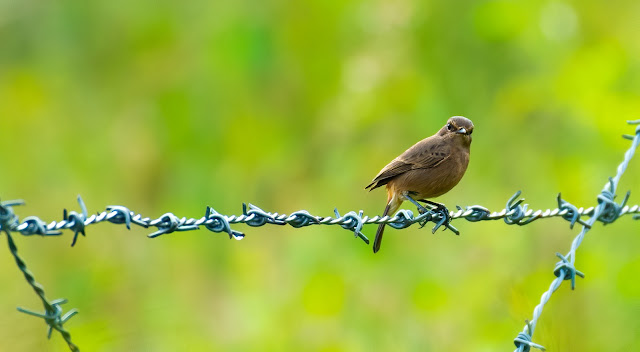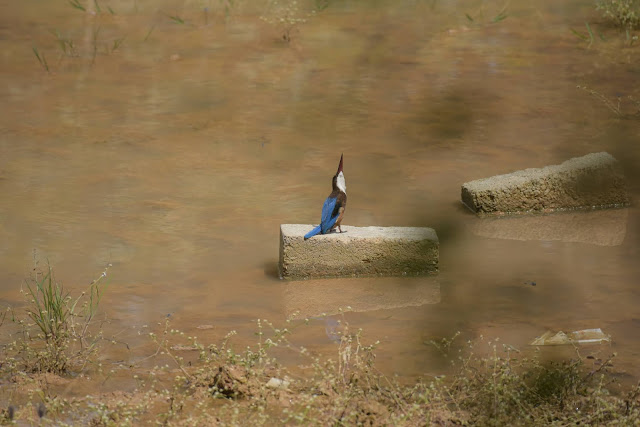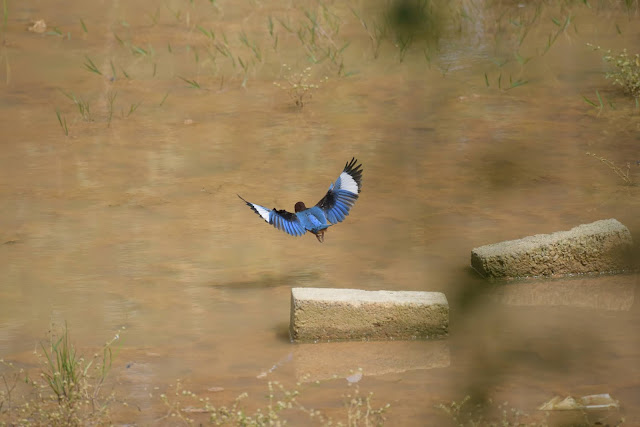 |
| Pied Bush chat female PC: Kalirajan Subramanian |
The summer of 2020 held high hopes for us. It was the much awaited vacation after our daughter’s board exams. For about two years, we hadn’t ventured anywhere far, due to tight academic schedules. Destinations like Ladhak and Spiti Valley were in our list. But destiny, as we all now know, had drastically different plans. The deadly virus that is still at large, knocked our doors right at the start of summer vacation in India and has managed to confine us mostly indoors.
From March to
October 2020, while writing this, human race continues to be cautious in
treading out. As we all learnt through the viral social media videoclips, this turned
out to be a coin with two contrasting sides - a bane to us but a boon to nature and
wildlife. Forests flourished in solitude and bountiful rains. Wildlife ventured
out of its constrained habitats and roamed carefree. But all of this good news only aggravated the
desperation and anxiety of the nemophilists, pluviophiles and orophiles among
us. With nowhere to go, we turned to our balconies, backyards and windows to
gasp and glimpse the magnificent macrocosm that has been unobtrusively
engulfing our lives, always. Largely, the confinement made many realize and
appreciate the beauty of the natural world around us.
My family
lives in an apartment near one of the most urbanised and busy areas of
Bangalore called the Marathahalli-Outer Ring Road junction. The metro in its
entirety has been agonisingly transforming from garden city to concrete city.
Yet it is refreshing to discover the many species of birds, reptiles or insects
that thrive in the abysmal green cover left-over amidst all the brick and
mortar.
One night around 9pm, I heard a call from the windows of our living room. The note was very distinct, characteristically repetitive and familiar through some of the birding knowledge-base available online. The pneumonic of the call was strikingly similar to “Did you do it?”.
It must be the Red Wattled Lapwing! At that moment, my curiosity and excitement knew no bounds. The call sounded so near, which meant the bird was somewhere in the vacant plot adjacent to our apartment, the one which our living room windows opened to. Without making any noise that might disturb or scare the bird, I stepped closer to the window and trained my eyes to scan in the faint visibility available outside. In few seconds, the slim tall ground nester was visible owing to its movements. It had made the plot with a small puddle of water and some bushes, as its nesting area. From that night it would regularly visit the place every dusk. Sometime its loud alarm calls were symbolic of the presence of some natural predator like stray dogs or mongoose. A month or so down the line, one night we were delighted to hear not just one but a few chorus calls. Could be the chicks too! So when we saw two stray dogs in the plot, we tried and shooed them off so that the chicks are safe. This was the first time it dawned on us that, Red wattled lapwings could be our neighbors too. Having seen them for the first time in a farm land in Agumbe ghats, we had always associated them to fields and much open spaces.
 |
Red wattled lapwing PC: Kalirajan Subramanian
Koels, Prinias, Tailor birds, Bulbuls, Mynahs and Pigeons were rather our usual guests along with a rare cameo from Cinerous tit. Infact the sweetest morning alarm is the call of the female Asian Koel to be followed so fondly by that of its male.
 |
Ashy Prinia as seen from our balcony PC: Kalirajan Subramanian
 |
Asian Koel Male PC: Kalirajan Subramanian
Cinerous Tit PC: Kalirajan Subramanian
 |
Common Rock Dove by the pool PC: Kalirajan Subramanian
 |
Doves and Mynah chilling by the puddle in the vacant plot adjacent to our apartment PC: Kalirajan Subramanian
On cloudy
or drizzly mornings there is another distinguished guest who announces its
presence through its call. The very unique “oop, oop, oop” note indicates the
presence of Southern Caucal around. Somedays it gracefully presents
itself on the trimmed Palmyra plant in our campus. As shy and alert as it is,
it would be so quick to cover itself under one of the large branches as soon as
we turn our heads towards it. One particular day, we were so lucky to click it
taking a dip in the puddle in the adjacent vacant plot.
 |
Southern Caucal planning a dip PC: Kalirajan Subramanian
The puddle is a chilling ground for quite a few birds. A large Indian black kite took a nice dip on a rare sunny day. A pair of White browed wagtails tried taking their share of water with the mynahs and pigeons one early morning.
 |
An Indian Black Kite just after a bath in the puddle PC: Kalirajan Subramanian
 |
Indian black kite dries its wings PC: Kalirajan Subramanian
Another interesting incident happened on a rainy late morning. It must have been around 10-11 am and it had just poured. The mynahs were returning back to the Plumeria and Copper pod trees gregariously greeting each other. Soon, their calls became noticeably loud and alarming. We were immediately pecked by this and peeped without opening the windows. The reason was sitting calmly on one of the branches – a Hawk cuckoo! Almost a doppelganger to Shikra, their predator, drove the poor mynahs into a screeching frenzy. The cuckoo, not withstanding the loud mob-defense from the mynahs, gave up after few minutes and took flight. If it were not for those enthralling alarm calls, we would have missed a great bird-watching opportunity.
This year it has been pouring abundantly in Bangalore, almost from late June to well into Dec. After every rain, there has always been some captivating moment in the natural world around. On another rainy morning, we had yet another vibrant guest on the trees. It was its unique call, that again gave its presence out. With work and school happening from home, all of us were deep into our own schedule when a repetitive metallic note caught our attention. At first we took it to be from a vehicle or mobile phone but soon its non-cacophonic-clarity prompted otherwise.
By now, we all have mastered our drill – move unobtrusively to the
closest window or balcony possible, watch in silence. This trick yields a high
success rate in observing the bird behaviors. This time too, it did. It was a Rufous
tree pie with its long tail and cinnamon-black-white plumage. We have read
that it has different calls but we were excited to hear 2-3 different types from
our window alone. Intriguing!
Our hitherto largely monochromatic/black/brown plumage spotting was broken one day with a streak of bright blue. We were having our breakfast at the table, our daughter facing the window that overlooked the tree. Suddenly she spurted out at the sight of a flying blue little thing that perched on the tree branch straight to her line of sight! Lo and behold, the puddle had allured a White throated kingfisher! And we were in for a delightful watch.
 |
| A White throated Kingfisher takes an aerial view of the puddle from the tree branch PC: Kalirajan Subramanian |
 |
| Moves close to its catch PC: Kalirajan Subramanian |
 |
| For a moment, looks at the skies PC: Kalirajan Subramanian |
 |
| Ready to take the plunge PC: Kalirajan Subramanian |
 |
| Plunge it does, and grabs its meal PC: Kalirajan Subramanian |
The scenes outside our window were proving to be far more interesting than any action drama in the streaming platforms. Very soon there was a Shikra that visited two days in a row.
 |
| Representative image of Shikra. Courtesy: Internet |
After almost six months since the first lockdown, we decided to make a short drive to some nearby open lung-space, for a change. So on a weekend morning, we drove to the city outskirts beyond Varthur, hardly 10 Km. from our residence. The green fields, coconut and teak groves were resplendent under the mild monsoon sun. A large banyan tree played the mystical ancestral home to so many bird species – Black rumped flameback Wood peckers, Babblers. Rose-ringed Parakeets meditatively hung on to the coconut leaves. Red whiskered bulbuls and a Pied bush chat were enjoying a friendly face to face chat unlike their human counterparts who were socializing mostly online.
 |
Red Whiskered Bulbuls and A Bush Chat PC: Kalirajan Subramanian
 |
A Red Whiskered Bulbul Conference PC: Kalirajan Subramanian
 |
Rose Ringed Parakeet PC: Kalirajan Subramanian
 |
Black rumped flameback Wood pecker PC: Kalirajan Subramanian
Few strides into the mud road brought us to a clearing with few shrubs and a rosewood tree. The tree hosted a spectacular array of deftly woven tubular nests.
 |
Baya Weaver Nests PC: Kalirajan Subramanian
 |
A weaver male looking out for materials to fabricate its nest PC: Kalirajan Subramanian
Ancient folklore and research both state that the entrance and the brood chamber of these nests are carefully designed to face the direction opposite to that of the blowing wind, so that any possible damage to the nest due to monsoon winds and rains is avoided.
 |
Self inspecting the nest PC: Kalirajan Subramanian
The
awareness this small bird has, on the natural forces and ecology, and the way
it applies these to live in unison with nature is simply astounding! No book or
school would teach anything remotely equivalent. We were lucky to observe them
from close quarters and carry home some invaluable life lessons.
Baya male with a carefully picked strand of long grass PC: Kalirajan Subramanian
Nature is
not far away, tucked only in dense forests and tall mountains. It is equally
here, now. Hopefully, the pandemic and a few lockdowns have helped us
understand this. Be it city centers, sub-urbs or country side – open,
inquisitive eyes and ears are all we need, to become aware of the fellow life forms existing in surprising
proximity to us. Homosapiens is the only species that has kept on drifting away
from nature, in the course of its evolution. Yet time and again, when our race
gets tired, it is to the lap of this very nature that we run, for solace. How
aptly we call those frantic searches as “breaks”! That development,
modernization, success and progress should only be built and measured on yardsticks
alien to nature, is illusory. The distance between the “routine” and the
“break” ought to reduce.
We can no
more afford to think of nature as a tourist spot that we pay and visit, only on
holidays. We are at a time when we need to collectively correct this fallacy. Nature
is an integral and essential aspect of our lives, without which our health and
well-being will be irreversibly impaired. Our progeny needs to enjoy what
little we have admired, inhaled and enjoyed in this planet. Systemically
opening our senses to the natural world around, enjoying their company right
from our homes and work places, is how it all needs to start. Every worm has
its place, every fly has its share and every life has its song. They ought to
be seen, heard and honored.
Reference: https://www.researchgate.net/publication/304343194_Nesting_of_Baya_Weaver_Ploceus_philippinus_in_S_R_T_M_University_Nanded_and_Fields_along_Asana_River_at_Nanded_Maharashtra_India

Comments